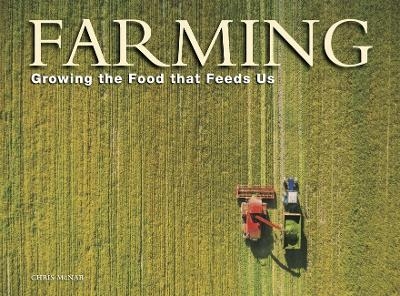
Farming
Amber Books (Verlag)
978-1-83886-255-8 (ISBN)
Farming – whether domestic crops, forestry, fish or livestock – is one of the pillars of human civilization, dating back to the early settlements of Neolithic times. Today, approximately one billion people work the land, providing food and other products for our ever-increasing human population.
Arranged geographically, Farming explores the many types of farm and farming that exist today. See how farmers in Malaysia extract milky latex from the bark of rubber trees, used to make everything from protective gloves to vehicle tires; be amazed at the gorgeous stepped rice fields of Bali, where the traditional subak irrigation system is created around ‘water temples’ and managed by Hindu priests; marvel at the vast corn and soya bean fields of Ontario, much of it used for animal feed to support Canada’s beef industry; learn about nomadic pastoralism in low rainfall areas such as Somalia, where herders move camels, cattle, sheep and goats in search of grazing; explore the wineries and vineyards in Bordeaux, where more than 700 million bottles of wine are produced each year by more than 8,500 châteaux; and see how freshwater prawns are harvested for export in the watery deltas of Bangladesh.
Presented in a landscape format and with more than 180 outstanding photographs of farming from every part of the planet, Farming offers a pictorial celebration of mankind’s deep connection with the land that sustains us.
Chris McNab is the author of more than a hundred books specializing in history, culture and geography for both the general and educational markets. His titles include Living off the Land, Farming: Operations Manual, Abandoned Wrecks, Iceland, Ghost Towns and Fakes, Scams and Forgeries. He also works as an educational publishing consultant, advising international agencies on how to develop textbooks and other educational resources.
Contents include:
Europe
• Livestock farming, cows and sheep – Germany, France
• Dairy farming – everywhere
• Fruit farming – Kent
• Hop farms and oast houses – Kent
• Hill farming – Wales
• High tunnel greenhouses
• Wind farms
• Oranges, apricots, lemons – Spain
• Wineries and vineyards – France, Germany, Italy, Spain, Greece
• Champagne, France – largest farms in France
North America
• Cattle ranches
• Arable crops – Midwest
• Peanut farms – Georgia
• Aquaponics
• Fruits, vegetables, and nuts –Salinas valley, California
• Corn belt – Iowa, Illinois, Indiana, southern Michigan, western Ohio
• Wheat belt – from Alberta tocentral Texas
• Cotton and tobacco farming – Deep South
• Catfish farm, Mississippi
• Scallop farms, Vancouver Island
• Cattle, grains and oilseeds – Alberta, Ontario, Saskatchewan
• Wild berries, caribou, musk, ox – Nunavut
Central & South America
• Sugarcane, coffee, soybeans – Brazil
• Cattle ranches – Argentina
• Cocoa – Ecuador
• Coffee, cocoa, plantation – Columbia
• Vineyards – Chile, Argentina
• Andean farming – maize, potatoes
Africa and the Middle East
• Nomadic herding – Saharan Africa (Mauritania, Mali, Niger, Chad, Sudan, Libya, Algeria)
• Farming around the Nile – crop rotation, corn (maize), rice, wheat, sorghum, and fava
• Citrus, wine, table grapes, corn and wool – South Africa
• Tea, coffee – Kenya
• Cocoa – Ivory Coast and Ghana • Maize and cassava – Nigeria
Asia and the Pacific
• Poppy farms – Afghanistan
• Fruit farms – Afghanistan
• Dry farming – India, Iran
• Tea plantations – India, Sri Lanka, Malaysia
• Rubber plantations – Thailand, Malaysia, Indonesia
• Rice cultivation – China, Thailand, Indonesia, Philippines, Vietnam
• Bali – subak irrigation system and water temples
• Sugarcane, cassava (manioc), corn (maize), sweet potatoes – Vietnam
• Sorghum farming – China
• Fish farms – Fujian coast, China
• Tilapia pens in Laguna de Bay, Philippines
• Slash-and-burn – Indonesia
• Subsistence farming – China, India, Nepal
• Fish farms – India, Bangladesh, Thailand
• Cocoa – Indonesia
• Palm oil – Malaysia, Sumatra, Borneo
• Coconut farming – Malaysia, Thailand
• Vertical farming – Japan
• Sugarcane – Queensland
• Stock farming – Australia
• Wheat, barley, chickpeas – Australia
| Erscheinungsdatum | 12.05.2023 |
|---|---|
| Reihe/Serie | Amazing Places Landscape |
| Zusatzinfo | Halftones, color |
| Sprache | englisch |
| Maße | 296 x 219 mm |
| Gewicht | 1430 g |
| Themenwelt | Kunst / Musik / Theater ► Fotokunst |
| Sachbuch/Ratgeber ► Natur / Technik ► Natur / Ökologie | |
| Sozialwissenschaften | |
| Weitere Fachgebiete ► Land- / Forstwirtschaft / Fischerei | |
| ISBN-10 | 1-83886-255-2 / 1838862552 |
| ISBN-13 | 978-1-83886-255-8 / 9781838862558 |
| Zustand | Neuware |
| Haben Sie eine Frage zum Produkt? |
aus dem Bereich


